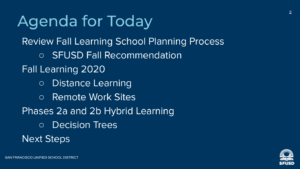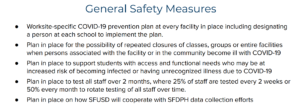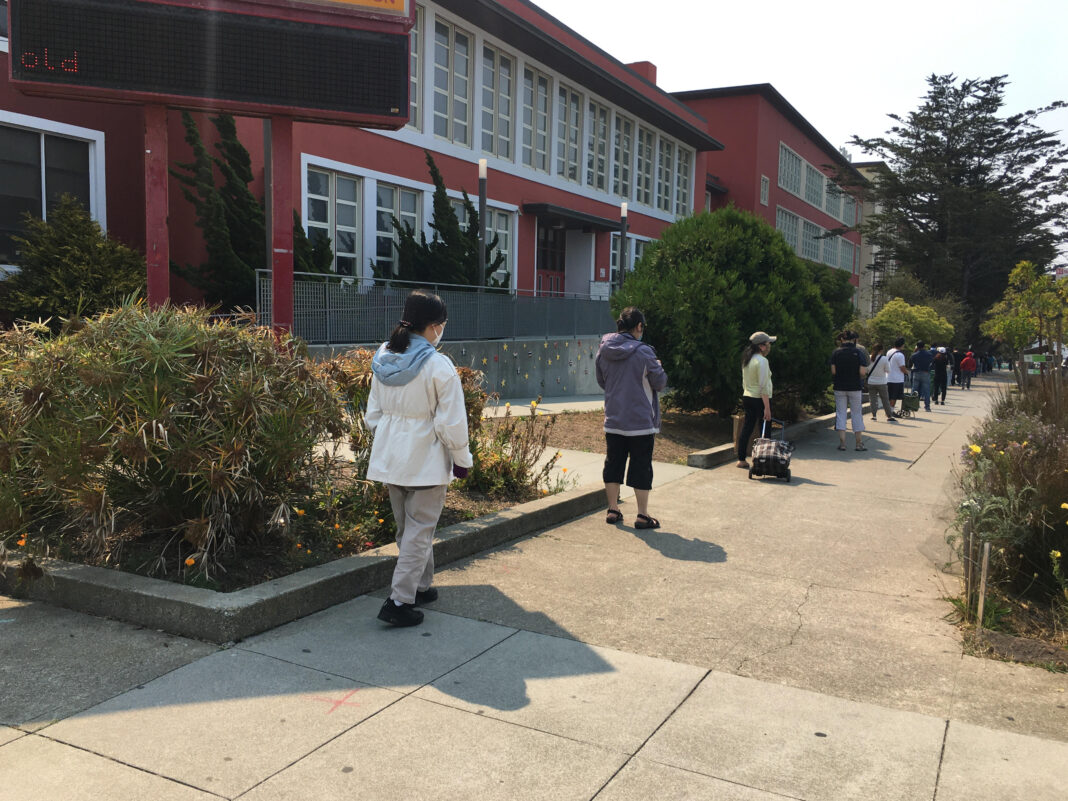SAN FRANCISCO—San Francisco Unified School District Superintendent Dr. Vincent Matthews and members of the San Francisco School Board discussed the District’s planning process to return to in-person instruction, prioritizing elementary school students and students with disabilities. The SFUSD meeting was held on September 22, and the issues discussed were summarized in an SFUSD press release published two days later.

(Courtesy of SFUSD Board Docs Page)
The SFUSD began the fall 2020 semester with remote virtual learning on August 17. The District announced plans to transition to a hybrid model. “Our district team is working diligently to deliver remote instruction while also putting everything in place to offer an in-person learning option to students most in need,” said SFUSD Superintendent Vincent Matthews. These students “most in need” are early elementary school students and special education students.
The SFUSD meeting’s presentation title was “SFUSD’s Fall Learning Plan Update September 22, 2020.” The plan included summaries for Phase 1, 2 and 3 of the Fall learning plan. Under the “Recommendations” slide, Phase 3 was characterized as “Full Return.” One bullet point read: “Our students benefit most from in-person instruction and appreciate human connection.”

(Courtesy of SFUSD Board Docs Page)
The presentation stated that maintaining the health and safety of students and staff was paramount. The presenters recommended gradual transition to in-person instruction in compliance with government health orders culminating in full return to in person-instruction. The presentation slides are accessible to the public and the PDF can be reached here: https://go.boarddocs.com/ca/sfusd/Board.nsf/files/BTNTNN783534/$file/Fall%20Learning%20Plan%20Board%20Presentation%20Update%202020-09-22.pdf
In Phase 1 of the SFUSD “Fall 2020 Learning Plan,” which is where the District’s schools are currently, all students are learning remotely. Under Phase 2A, the District is planning for a gradual return for a small cohort of students focusing on early elementary school students and students with disabilities in moderate/severe special day classes. This plan includes safety protocols and measures to minimize the spread of COVID-19 under the “purple tier” in the State of California’s 4-tier color-coded system for tracking COVID-19 trends in various counties.
The four tiers include widespread (purple), substantial (red), moderate (orange), and minimal (yellow) according to the California government. The tier system, or “blueprint” for reducing COVID-19 cases with criteria on loosening or tightening activities can be accessed at https://covid19.ca.gov/safer-economy/.
Under Phase 2B, the District is preparing for a return for homeless and foster youth, those who have shown the “lowest overall online engagement.” This plan includes safety protocols and measures to minimize the spread of COVID-19 under the “red tier.” This plan requires conditions under the “red tier” to go into effect. The visuals showing the decision trees for Plan 2A and 2B can be accessed on the SFUSD website: https://www.sfusd.edu/phase-2a-small-cohortgroup-return
“We are committed to the health and safety of our students and staff. I see how hard everyone is working to make the best decisions under these dire and unprecedented circumstances,” said SFUSD Board President Mark Sanchez in the press release.
According to the press statement, SFUSD is developing health and safety protocols for in-person learning. The list of preparations, rules, and planned protocols, include the requirement that all students and staff wear face coverings, screening students each morning, and designating an “isolation area” for anyone experiencing COVID-19 symptoms. Daily health questionnaires for staff will be conducted to affirm they are not experiencing COVID-19 symptoms prior to entering a building or office space. Educators are to conduct daily safety protocols and complete safety training.
All public institutions of activity in San Francisco are required to follow City and County health orders. Protocols include posting signage promoting safe practices, and cleaning and disinfecting all “high-touch” surfaces daily.
The District is creating protocols to limit the sharing of objects and supplies inside the school building, including offering school meals in smaller, controlled settings, arranging classroom furniture to allow for 6 foot social distancing, training employees and students in hygiene, and minimizing non-essential visitors and volunteers to school sites.
Plans for outdoor learning, athletics, and extracurricular activities are also in process.
“Distance learning is not a substitute for the in-person school experience. The intent of distance learning is and continues to be to mitigate the risk of COVID-19 transmission,” Matthews said in an expression of his opinion on the nature of virtual learning.
Cooperation and compliance with San Francisco Department of Public Health orders was repeated throughout the presentation. Plans are in place for the possibility of “repeated closures of classes, groups or entire facilities” when persons associated with the facility or in the community become ill with COVID-19. Currently, public school buildings are used to distribute meals and certain operations.
“San Francisco educators remain committed to getting back to in person learning as soon as it is safe to do so. Right now we are focused on fully understanding what all of the benchmarks are and how we can get our more vulnerable students back as soon as possible,” said the United Educators of San Francisco President, Susan Solomon.







